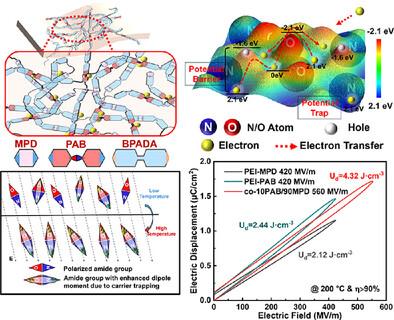Remarkable High-Temperature Energy Storage in Co-Polymerized Polyetherimide Via Constructing Hybrid Electrostatic Potential Barriers
IF 18.5
1区 材料科学
Q1 CHEMISTRY, MULTIDISCIPLINARY
引用次数: 0
Abstract
High-temperature dielectric polymers are increasingly attracting significant interest for energy storage applications in harsh environments. However, the exponentially increased conduction losses under high temperatures and elevated electric fields often cause serious degradation of the capacitive performance of dielectrics. Unlike most reported energy-level tuning strategies, this study introduces a novel approach that constructs localized electrostatic barriers to enhance the high-temperature energy storage of polyetherimide (PEI) films. By copolymerizing amide groups MPD (1,3-Phenylenediamine) and PAB (4,4′-Diaminobenzanilide) into the PEI backbone, the strong electrostatic separation effect of amide dipoles is established, leading to a significant electric potentials difference. Density Functional Theory (DFT) proves that intermolecular local potential fluctuations generate significant hybrid electrostatic barriers (4.2 eV) to trap carriers and suppress their migration within the spatial freedom domain. Consequently, the largely suppressed leakage current and enhanced breakdown strength are yielded in co-10PAB/90MPD polymer, creating a high energy density of 4.3 J cm−3 (η > 90%) at 200 °C as comparison to the original PEI-MPD (2.1 J cm−3), which surpasses most high-temperature energy storage polymers. This work demonstrates a promising paradigm of dipolar regulation at the molecular level for high-temperature dielectrics.

通过构建杂化静电势垒,共聚聚醚酰亚胺具有显著的高温储能性能
高温介电聚合物在恶劣环境下的储能应用越来越引起人们的极大兴趣。然而,在高温和高电场条件下,导电损耗呈指数级增长,往往导致电介质的电容性能严重下降。与大多数报道的能级调谐策略不同,本研究引入了一种新的方法,即构建局部静电屏障来增强聚醚酰亚胺(PEI)薄膜的高温储能。通过将酰胺基团MPD(1,3-苯二胺)和PAB(4,4′-二氨基苯二胺)共聚到PEI骨架中,建立了酰胺偶极子的强静电分离效应,导致了显著的电位差。密度泛函理论(DFT)证明了分子间局部电位波动会产生显著的杂化静电势垒(4.2 eV)来捕获载流子并抑制其在空间自由域内的迁移。因此,co-10PAB/90MPD聚合物的泄漏电流得到了很大程度的抑制,击穿强度得到了增强,能量密度达到4.3 J cm−3 (η >;与原来的PEI-MPD (2.1 J cm−3)相比,在200°C下达到90%),超过了大多数高温储能聚合物。这项工作证明了在高温电介质分子水平上偶极调节的一个有前途的范例。
本文章由计算机程序翻译,如有差异,请以英文原文为准。
求助全文
约1分钟内获得全文
求助全文
来源期刊

Advanced Functional Materials
工程技术-材料科学:综合
CiteScore
29.50
自引率
4.20%
发文量
2086
审稿时长
2.1 months
期刊介绍:
Firmly established as a top-tier materials science journal, Advanced Functional Materials reports breakthrough research in all aspects of materials science, including nanotechnology, chemistry, physics, and biology every week.
Advanced Functional Materials is known for its rapid and fair peer review, quality content, and high impact, making it the first choice of the international materials science community.
 求助内容:
求助内容: 应助结果提醒方式:
应助结果提醒方式:


